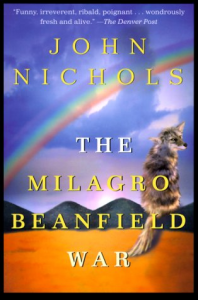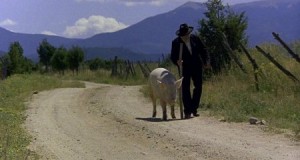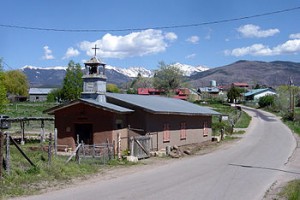A whole bunch of quirky characters appear in this magical film, which I wrote about in 2012.
 The word “quixotic” has its roots in—what else?—Don Quixote, the subject of my last post. By definition the word means, “Foolishly impractical, especially in the pursuit of ideals; marked by rash, lofty romantic ideas or extravagantly chivalrous action.”
The word “quixotic” has its roots in—what else?—Don Quixote, the subject of my last post. By definition the word means, “Foolishly impractical, especially in the pursuit of ideals; marked by rash, lofty romantic ideas or extravagantly chivalrous action.”
Yep, that sounds like Don Quixote.
It also sounds like a guy named Joe Mondragon. Joe is the lead character in one of my most-watched movies, The Milagro Beanfield War. This 1988 film, directed by Robert Redford and considered a work of magical realism, is easily one of the thirty (or forty? or fifty?) movies in my Top Ten. It is based on a novel by the same name, written by John Nichols, and was the first of a trilogy that includes The Magic Journey and The Nirvana Blues. Nichols also wrote the screenplay.
 The fictional town of Milagro (Spanish for “miracle”), located in the stunning mountains of northern New Mexico, has a population of a few hundred people, mostly Hispanic. When politicians make a shady deal with business interests to build a resort, garage owner Ruby Archuleta (Sonia Braga) and newspaperman/lawyer Charlie Bloom (John Heard) try with minimal success to convince the locals that they’re doubtless going to be screwed in the long run. Among the concessions made to slimy rich guy Ladd Devine are the town’s water rights.
The fictional town of Milagro (Spanish for “miracle”), located in the stunning mountains of northern New Mexico, has a population of a few hundred people, mostly Hispanic. When politicians make a shady deal with business interests to build a resort, garage owner Ruby Archuleta (Sonia Braga) and newspaperman/lawyer Charlie Bloom (John Heard) try with minimal success to convince the locals that they’re doubtless going to be screwed in the long run. Among the concessions made to slimy rich guy Ladd Devine are the town’s water rights.
Enter Joe Mondragon, a young, underemployed family man. Although a capable jack-of-all-trades, he cannot find work with the development company, which won’t hire any locals. Nor can he farm, because of the water issue. Angry, he stops at his late father’s dormant beanfield, where he “accidently” kicks a valve alongside an irrigation ditch and diverts water into the field. He then decides to plant a bean crop, if for no other reason than to protest what is happening to his town. His quixotic efforts win the support of many in the town—and, of course, the animosity of the powerful business and state interests, the governor sending a rather nasty “lawman” (Christopher Walken) to Milagro to undermine Joe’s efforts. A series of confrontations follow, these escalating to the ultimate face-off between the people of the town and a bevy of law enforcement.

Amarante and friend
Among the many delightful and quirky characters populating the story (one group is known as the Senile Brigade), my hands-down favorite is an old man named Amarante Cordova. Played by renowned Mexican actor Carlos Riquelme (who, sadly, passed away not long after the release of the movie), Amarante and his huge, aggressive pig live near the beanfield. Every morning, upon awakening, Amarante examines himself in the mirror to make sure he’s alive and then says, “Thank you God, for letting me have another day.” Then, in keeping with the film’s magical realism theme, he goes outside and has a chat or plays chess with a character called Coyote Angel, a large-sombreroed, cussin’ spirit that only Amarante can see. Ultimately Amarante plays a key role in the “war” between the two factions.

Truchas, New Mexico
My wife and I enjoy visiting the towns where some of our favorite movies were made. We went to Dyersville, Iowa to see the Field of Dreams, and Madrid, New Mexico (pronounced MAH-drid), where they filmed part of Wild Hogs, among others. The Milagro Beanfield War was filmed in Truchas, New Mexico, and when I found out that Truchas was not far from Santa Fe, a favorite vacation destination, we just had to go there a while back. Guess what, the town was so small that we drove through it and had to turn around. Seriously. The general store (the only store, I think) had no souvenirs of the film. A guy who worked there could hardly recall anyone ever asking. But, we got to “Milagro,” so what the heck…
Okay, so it wasn’t a blockbuster; hardly grossed much money. But The Milagro Beanfield War is a funny, inspirational, heartwarming, magical story and well worth the two hours of viewing time. Enjoy!
